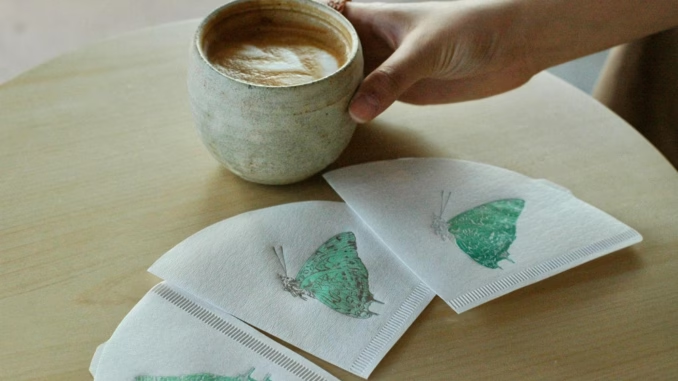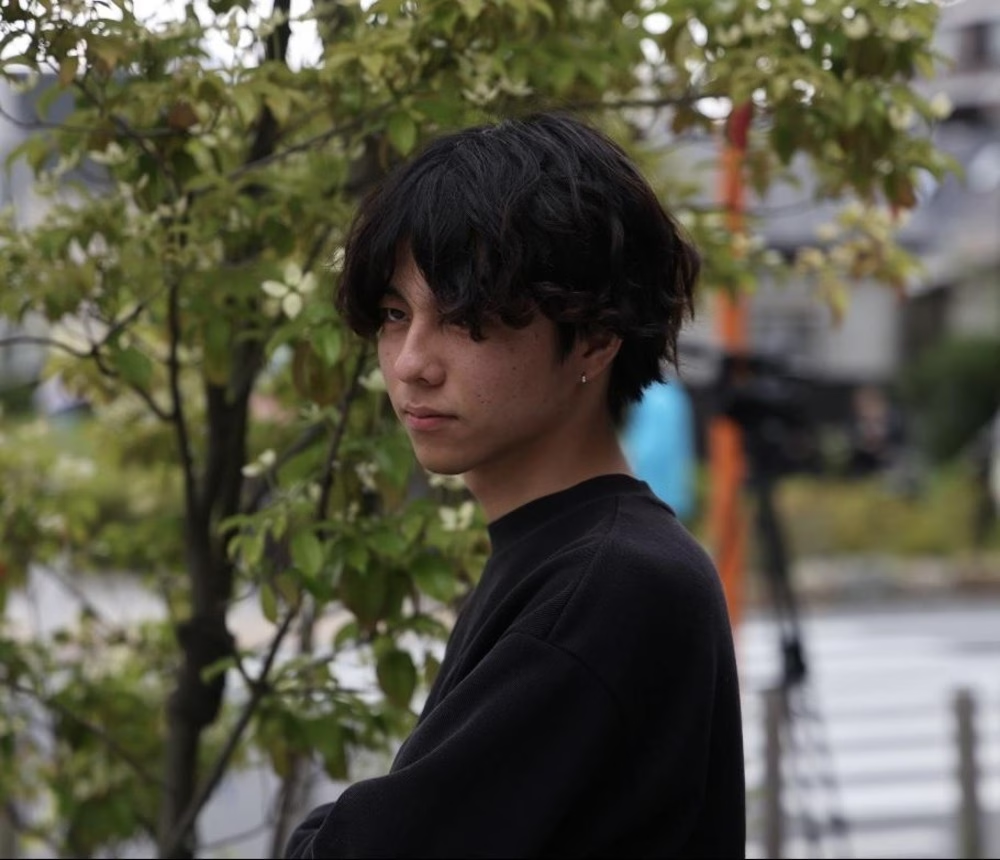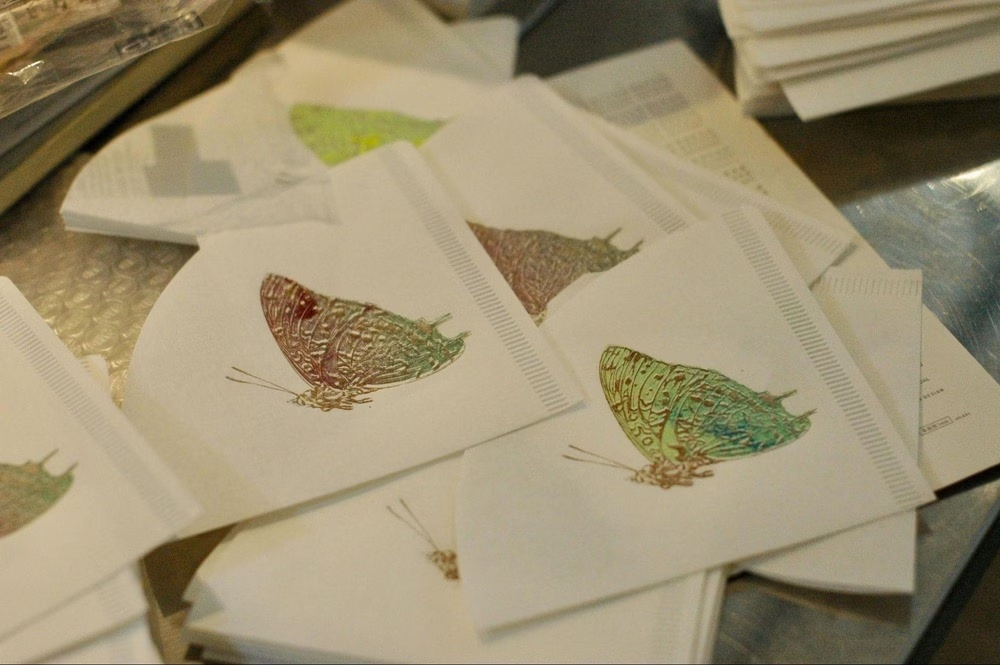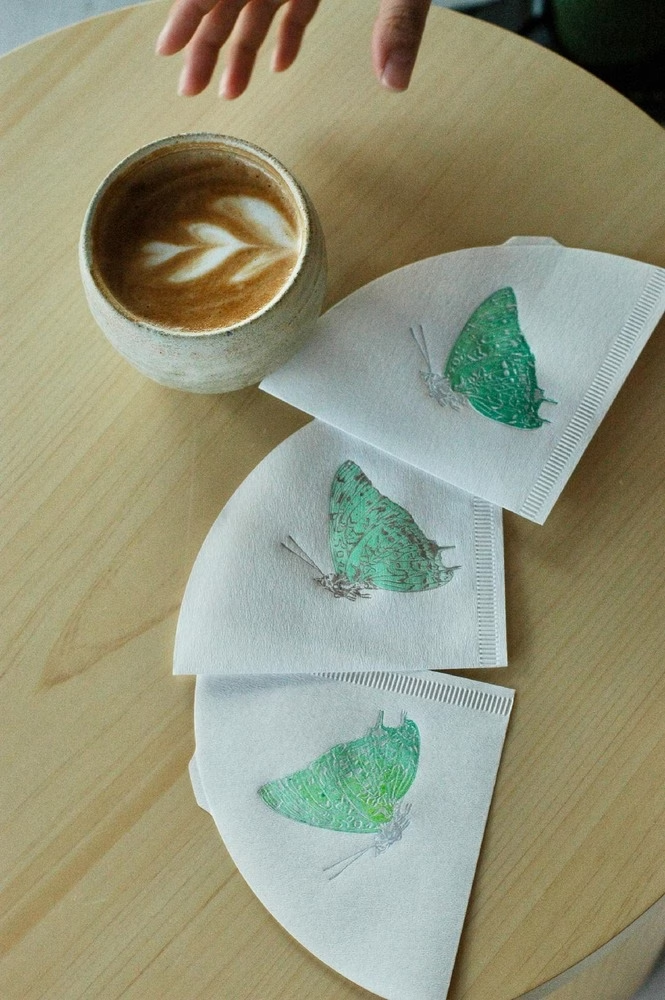A Conversation with Zenya Toyama, the Creative Turning Coffee Filters into Art

The Tokyo, Japan-based artist shares the inspiration behind upcycling used coffee filters into canvases for striking artwork.
BY VASILEIA FANARIOTI
SENIOR ONLINE CORRESPONDENT
Photos courtesy of Zenya Toyama
I first came across Zenya Toyama’s artwork in an event space in Tokyo, Japan. At first glance, it looked like a scientific illustration—delicate butterflies pinned to paper. But the “canvases” turned out to be used coffee filters, and each butterfly came from a coffee-growing region. The stains, the colors, the origins … they all told a deeper story. I sat down with Zenya to talk about the connection between butterflies and coffee, visual flavor, and how art can reshape how we experience what’s in our cup.


Vasileia Fanarioti: How did the idea of painting butterflies on coffee filters first come to you?
Zenya: One day, while making pourover coffee at home, I looked at the used filter and was struck by the intuitive beauty of the stained coffee tones. Over time, the interaction of materials created subtle patterns that reminded me of wabi-sabi—the Japanese aesthetic of impermanence and imperfection. That moment sparked the idea of using disposable coffee filters as a canvas for expression.
Why butterflies—and why those from coffee-producing regions? What do butterflies symbolize for you in the context of coffee?
I wanted to convey more than just the flavor of coffee. I wanted to express the landscapes and communities behind it. Butterflies, as endemic species with singular beauty, were a perfect fit. They’re also known as indicator species—very sensitive to environmental changes, just like coffee. By painting butterflies from coffee-producing regions, I aim to evoke the invisible nature and spirit of the land that lives inside each cup.


You’ve mentioned that the structural color in butterfly wings reminds you of the shifting flavors in coffee. Can you elaborate on that connection?
Structural color is produced by microscopic surfaces that reflect light differently depending on the angle—creating a sense of movement and depth. That reminds me of how coffee flavor evolves as it cools. What might start as a deep chocolate note could become citrusy or spicy. Just like a butterfly wing, coffee reveals its layers with time. That connection—between color and taste—is central to the project.
Also, research like “Cup colour influences consumers’ expectations and experience on tasting specialty coffee” helped me explore how visual perception shapes flavor. That was a big inspiration, too.
The reference to triangular specimen envelopes is a beautiful detail. What meaning do you intend by replacing them with coffee filters?
Traditional triangular envelopes used to preserve butterflies symbolize distance, journey, and the unknown. In my work, coffee filters take on that role. Like butterflies, coffee travels—across borders, cultures, and hands. By painting butterflies on filters, I try to build a sensory bridge between “a land where someone once was” and “the moment here and now.” It’s a way to ask viewers to reconsider consumption, nature, and their place in the cycle.



You’ve created 161 butterflies so far—how were the species chosen? Does the number have a special meaning?
There’s no symbolism behind the number—161 just represents the number of physical prints I’ve been able to complete so far. It’s a technical process: Capturing the nuanced colors of butterfly wings requires fine adjustments and deep dialogue with print technologies. So 161 is more like a snapshot of a journey in progress. My goal is 300 color variations, each matched to a sensory coffee experience. Right now I’m focused on Ethiopian species, but I’ll expand into Central and South America, and Southeast Asia next. You can see the visual and barista matching process on my portfolio site.



You collaborated with baristas to match butterfly colors with coffee flavors. How did that process unfold? Any surprises?
It started with a simple question: “If this butterfly were a flavor, what would it taste like?“ I expected totally different answers. But surprisingly, many baristas had similar responses—maybe because we share a common flavor vocabulary from cupping. Still, everyone added personal nuance. Some baristas linked flavors to travel memories; others recalled customers or café moments. That blend of shared language and individual story became one of the most touching parts of the project.
I hear you’re also collecting environmental sounds from coffee farms. What kind of experience are you hoping to deliver in future exhibitions?
I want to create a multisensory experience that fuses butterfly × taste × sound × space. Imagine: You’re standing in front of an Ethiopian butterfly illustration, hearing the forest at dawn, and sipping a cup that mirrors the colors. I want to move people from passive tasting to immersive feeling. If the work leaves behind a memory—one that’s more than taste—I’ll feel I succeeded.



This is clearly a deeply collaborative project. How do you see co-creation with people outside the art world?
Traditional painting often highlights beauty as a final product. But this project is more about experience—highlighting traces of time, place, and material. That can’t happen alone. So, I work with people from different fields—baristas, producers, technologists, even musicians. It reflects the journey of coffee itself, from grower to cup. To me, co-creation is a quiet form of world peace. A gesture of mutual respect.
Finally—what’s next? Are there new senses or directions you’d like to explore?
I’d love to bring the project into real-life spaces—cafés and galleries where people can encounter the artwork and coffee together, organically. I also want to visit coffee origins and collect sensations firsthand—landscapes, butterflies, voices, air. Ultimately, I hope the project becomes a place for people who love coffee to taste, learn, speak, and feel together—where art connects humans not just to each other, but to the land itself.
ABOUT THE AUTHOR
Vasileia Fanarioti (she/her) is a senior online correspondent for Barista Magazine and a freelance copywriter and editor with a primary focus on the coffee niche. She has also been a volunteer copywriter for the I’M NOT A BARISTA NPO, providing content to help educate people about baristas and their work.
Subscribe and More!
As always, you can read Barista Magazine in paper by subscribing or ordering an issue.
Read the June + July 2025 Issue for free with our digital edition.
For free access to more than five years’ worth of issues, visit our digital edition archives here.
Source: Barista Magazine



